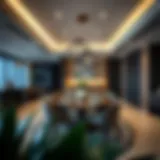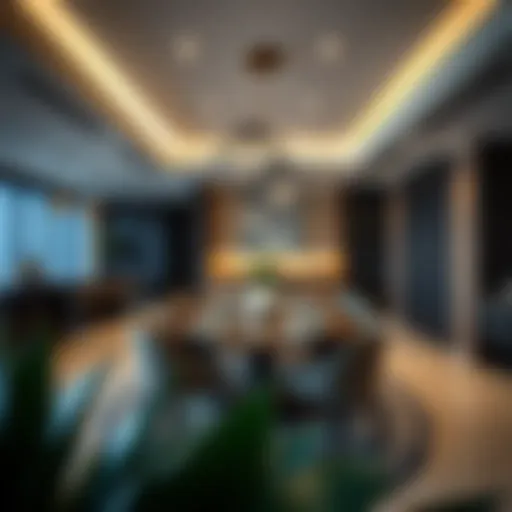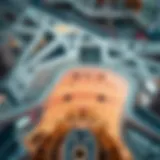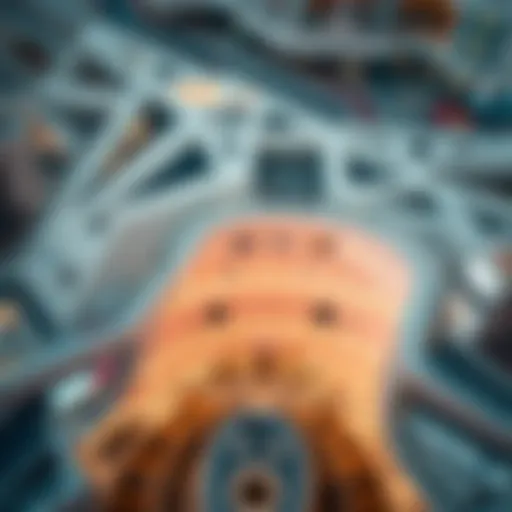Discovering Dubai's Vibrant Souks: A Cultural Journey
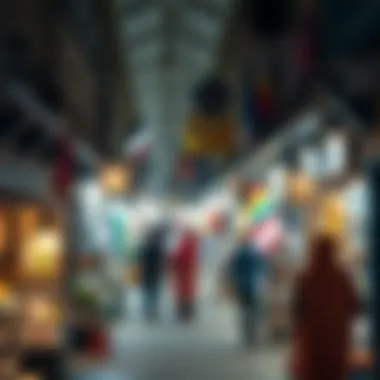
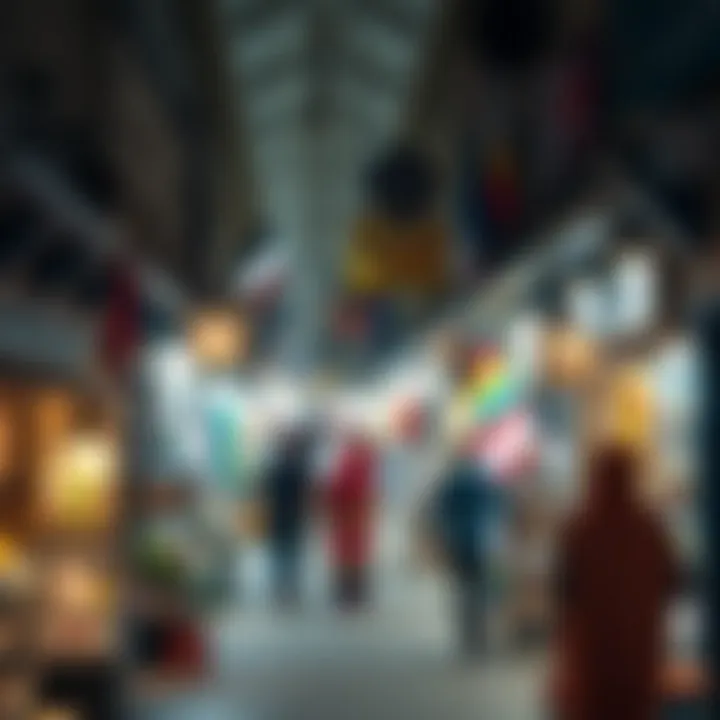
Intro
Dubai, a city that juxtaposes the glitz of skyscrapers against the allure of its traditional markets, is home to some of the most fascinating souks. These markets, with their ornate architecture and bustling atmosphere, are not mere shopping destinations; they offer a window into the rich cultural heritage of the Emirate. Each souk tells a story, showcasing a unique blend of local craftsmanship, culinary delights, and the age-old tradition of negotiating prices.
Visiting Dubai's souks is akin to taking a stroll through time. From vibrant textiles to shimmering jewelry, the goods found within these markets reflect the city's history as a trading hub. In this article, we will take a deep dive into the various souks scattered throughout the city, highlighting both the prominent spots and those that slip under the radar yet hold tremendous charm.
This exploration also emphasizes practical insights essential for visitors. Bargaining is an integral part of the shopping experience in the souks, and knowing how to navigate the art of negotiation can lead to treasures at a bargain price. Moreover, getting familiar with the various neighborhoods where these markets reside can aid both tourists and investors looking to immerse themselves in this captivating aspect of Dubai's culture. Get ready as we embark on this immersive journey through Dubai's best souks.
Prolusion to Dubai's Souks
Dubai’s souks, the city’s traditional markets, are more than just places to shop; they are hubs of history and culture, reflecting the rich tapestry of Emirati heritage. This article strives to paint a vivid picture of these bustling marketplaces, diving into their distinctive characteristics and highlighting both popular and lesser-known souks. For investors, real estate agents, and market analysts, understanding the unique blend of tradition and modernity found in these souks could reveal opportunities within the local economy.
Historical Context
The history of the souks in Dubai stretches back to its humble beginnings as a fishing village and trading port. As merchants sailed in from Europe, Asia, and Africa, the souks served as a meeting point for a diverse range of goods and cultural exchanges. Key commodities like spices, textiles, and gold began to flow through these markets long before Dubai became the modern metropolis we know today.
For instance, the Gold Souk remains rooted in its ancient function as a trading site for ornamental gold pieces and jewelry that epitomize the wealth from centuries of commerce. The Spice Souk pays homage to the routes taken by spice traders, linking Dubai to far-flung destinations such as India and Indonesia.
"A visit to the souks is like taking a step back in time, immersing oneself in the very moments that shaped Dubai's prosperity."
This important historical framework sets the stage for understanding the contemporary significance of these markets, allowing visitors to appreciate the stories woven into their winding pathways.
Cultural Significance of Souks
Souks are not just shopping venues; they are vibrant cultural crossroads. Each market holds a mirror to the local lifestyle, representing the flavors, smells, and colors of the UAE. The Textile Souk, for example, showcases a kaleidoscope of fabrics draped enticingly, ranging from silk to traditional Emirati attire. Here, the artistry of fabric weaving comes alive, inviting buyers to experience a tactile connection with the cultural identity of the region.
Moreover, souks play an essential role in fostering community bonds. Locals gather not only to shop but to exchange stories, partake in traditions, and strengthen social ties. This communal aspect is especially prominent during festive seasons, when souks are abuzz with decorations and vibrant activities.
Visitors to these markets can find more than just material goods; they will encounter the very essence of Dubai’s zest for life, hospitality, and craftsmanship. It’s a space where every corner whispers tales of the past while hosting the dreams of the future.
The Gold Souk
The Gold Souk is not just a market; it's a vibrant tapestry of tradition interwoven with the bustling life of Dubai. For years, this souk has been a cornerstone of the city's commerce, luring a mix of locals and tourists who come to experience the brilliance of gold jewelry and gain insights into a unique facet of Emirati culture. Here, gold isn't merely a commodity; it embodies artistry, history, and the very essence of luxury that Dubai represents.
Overview of the Gold Market
Stepping into the Gold Souk, the first thing you notice is the sheer opulence that surrounds you. Hundreds of shops displaying intricately designed gold pieces shimmer like stars on a clear night, creating an irresistible allure for anyone who walks through its doors. The market spans a network of winding alleys filled with a range of goldsmiths, from small family-run businesses that have been passed down through generations to larger, more modern establishments.
The gold available here varies widely in quality and style, with items often crafted from 22K and 24K gold available at competitive prices. Whether one is looking for traditional Arabic designs, contemporary styles, or unique pieces inspired by global trends, this souk has it all. Understanding the local measurement system, like the uncial weight, is crucial for anyone considering a purchase, as gold is often sold by weight rather than piece.
Additionally, the Gold Souk plays a pivotal role in the local economy, attracting investors and business enthusiasts eager to explore this influential sector. Its reputation for having some of the most competitive prices worldwide makes it a hotspot for both personal buyers and retailers looking to stock up on high-quality gold.
Buying Gold: Insights and Tips
When it comes to buying gold in the Gold Souk, a little preparation can go a long way. Here are some practical tips to keep in mind:
- Research Market Prices: Prior to visiting, familiarize yourself with the current gold prices to ensure you have a fair negotiating ground. Websites like goldprice.org can provide up-to-date insights.
- Inspect Quality: Check for the hallmark on the items that guarantee authenticity. Each piece should be marked, ensuring it meets quality standards.
- Negotiate: Haggling is a common practice at the souk. Don't be shy about bargaining; many vendors expect it. Start lower than your intended purchase price and be willing to walk away if necessary.
- Consider Customization: One of the unique aspects of the Gold Souk is that many merchants offer customization options. This means you can design a piece that is uniquely yours, whether it be an intricate pendant or a set of earrings.
- Payment Methods: While cash is king here, some shops may also accept credit cards. Always confirm payment options beforehand.
When you visit the Gold Souk, you aren't just buying gold—you're purchasing a piece of history, artistry, and culture.
In summary, the Gold Souk is a must-visit for anyone seeking to understand the true essence of luxury in Dubai. Equally attractive to both seasoned investors and casual shoppers, it offers an unparalleled glimpse into a world where tradition meets the modern market. With proper planning and negotiation skills, visitors can navigate this dazzling marketplace and emerge with treasures that are not only beautiful but laden with stories.
Spice Souk: A Sensory Experience
The Spice Souk is not just a marketplace; it's a vibrant tapestry of the senses woven together by the colors, aromas, and textures of a treasure trove of spices. Located in the heart of Dubai, this bustling souk represents a microcosm of the city's rich history and its enduring connection to trade. Here, visitors are not merely shoppers; they become explorers in a world where the essence of spice fills the air, inviting everyone to partake in its bountiful offerings. By engaging with the Spice Souk, you can gain not just spices for your cooking but insights into a facet of Dubai’s cultural and culinary heritage.
Exploring Spice Varieties
Walking into the Spice Souk is akin to stepping into a vibrant kaleidoscope. The first thing that strikes you is the brilliant display of colors - deep reds of paprika, hues of yellow from saffron, and earthy tones of cumin. This isn’t just a feast for the eyes; it's an olfactory wonderland that invites you to linger.
Here are some spices you'll likely encounter:
- Saffron: Known as the world's most expensive spice, it brings a luxurious flavor and vibrant color to dishes.
- Sumac: A tangy, lemony spice that adds depth to meats and salads.
- Za'atar: A blend that comprises thyme, oregano, and sesame seeds, famous for its use in Middle Eastern cuisine.
- Cardamom: Often used in both sweet and savory dishes, it adds complexity and a sweet note to everything from coffee to curries.
- Dried herbs: Not just spices, you'll also find various dried herbs that can elevate everyday meals.
Each vendor is eager to share their knowledge, offering tastings or explaining the origins and uses of their spices. The exchange isn’t only transactional; it fosters a rich culture of sharing culinary secrets and traditions.
Culinary Uses of Spices
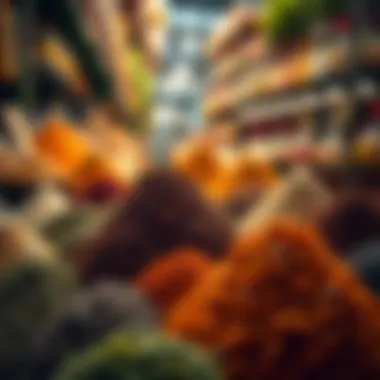
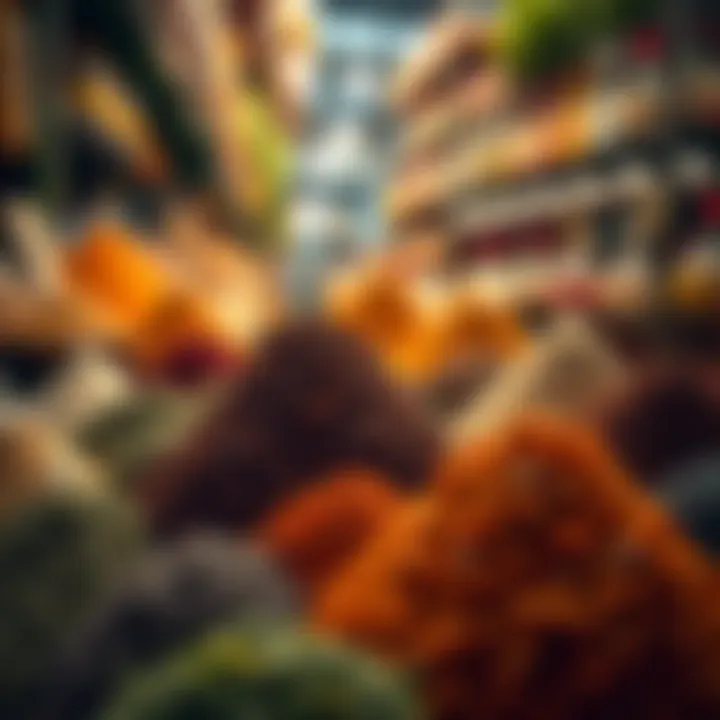
The culinary applications of spices found in the Souk extend far beyond mere seasoning. Spices have been the backbone of various cuisines for generations, and their significance in cooking cannot be overstated. Let’s look at how these aromatic treasures can transform your culinary creations:
- Enhancing Flavors: A pinch of sumac can elevate a simple chicken dish, while saffron can turn plain rice into an exquisite meal.
- Aromatics: Spices such as coriander and cumin not only add flavor but also infuse dishes with rich aromas that tantalize the senses.
- Health Benefits: Many spices possess medicinal properties. Turmeric, for instance, has anti-inflammatory benefits and is considered a nutritional powerhouse.
- Cultural Dishes: Certain spices are integral to cultural recipes. For example, cardamom is essential in Persian rice dishes, while cumin is powerful in many Indian curries.
The Spice Souk is not merely about acquisition; it's about appreciating the role these ingredients play in our diets and lives. Encountering various spices in their raw form offers an authentic glimpse into culinary traditions that have been passed down through generations.
“A good meal can tell a story, and spices are the unsung heroes of that tale.”
Visitors can explore these spices, learning tips on how to use them effectively in their cooking. Local sellers often share recipes or cooking methods that are popular within their culture, enhancing the shopping experience and offering practical value.
By the end of your visit to the Spice Souk, you leave with not only exotic spices to take home but also a deeper understanding of their rich histories and culinary potential. It’s an experience that lingers long after the last whiff of cinnamon fades.
The Textile Souk
The Textile Souk, nestled in the heart of Bur Dubai, acts as a vibrant showcase of color and creativity. It's more than just a shopping destination; it embodies a cultural tapestry woven from the rich heritage of the UAE. For investors and developers eyeing opportunities in the textile industry, understanding this souk is essential. It hints at market trends, consumer preferences, and the burgeoning demand for quality fabrics that reflect both traditional craftsmanship and modern styles.
Types of Fabrics Available
Visitors to the Textile Souk are greeted with an array of fabrics from all corners of the world. You might find:
- Silk: Luxurious and smooth, often imported from countries like India and China. Ideal for garments and home decor.
- Cotton: A staple in many wardrobes, combining comfort and breathability. You'll see everything from basic white cotton to finely printed varieties.
- Linen: This fabric stands out for its natural aesthetics and suitability for the desert climate. Its usual use ranges from dresses to table linens.
- Wool: Perfect for cooler evenings, woolen fabrics are often used in traditional attire.
- Synthetic Blends: Many vendors offer modern blends that offer durability alongside unique designs. These fabrics cater to a wide audience, from fashion-forward individuals to budget-conscious shoppers.
Each type of fabric has its own story, made unique by the artisans who weave them. Shoppers can talk to the merchants, many of whom are family-run businesses, who take pride in their craft and offer insights into their products.
Cultural Importance of Textiles
Textiles have long played a vital role in the social fabric of the Middle East. In the UAE, they serve as markers of status and cultural identity. The vibrant patterns and handiwork seen in this souk reflect the history and traditions of the region. It's a visual storybook where every piece of fabric carries a tale of its origin and the craftsmanship that went into making it.
Moreover, textiles are not merely items of clothing; they symbolize a community's resilience and artistry. Traditional garments like the abaya and kandura have evolved, merging modern styles with cultural significance.
Investors must recognize these cultural nuances, as they inform consumer preferences and dictate trends within the market.
"Textiles in Dubai's souks are not just bought or sold; they are heritage that thrives in an ever-changing world."
For anyone interested in the textile business or simply looking for genuine art pieces, these markets serve as a barometer for where textile trends are headed. A visit to the Textile Souk isn’t just a shopping experience; it’s an immersion into the local culture, making it an essential stop on any exploration of Dubai's souk landscape.
Perfume Souk: Fragrant Treasures
The Perfume Souk in Dubai represents a captivating slice of cultural richness and sensory delight. Nestled amidst the bustling atmosphere that defines the city, this souk is a paradise for those with an appreciation for fragrant artistry. Here, the essence of tradition and modernity come together in a bustling market setting. Shoppers can find not just perfumes, but also the stories that accompany each scent, echoing the deep-rooted practices of perfumery that are integral to the Arab heritage.
Types of Fragrances
When it comes to fragrances, the Perfume Souk showcases an extensive variety that can enchant even the most discerning nose. From classic floral scents to exotic musk blends, the options are plentiful. Visitors can encounter:
- Attars: These are oil-based perfumes, derived from natural sources like flowers and herbs. They are famously concentrated and long-lasting, making them a favorite among locals and tourists alike.
- Oudh: This fragrance is derived from the heartwood of the Agar tree. It’s known for its deep, woody aroma, which resonates with the Middle Eastern palette. Oudh is often blended with other scents, creating layers of complexity.
- Floral blends: Jasmine, rose, and sandalwood are common base notes that many can’t resist. The floral notes evoke a sense of nostalgia and beauty, often reminding buyers of cherished memories.
- Spicy and sweet blends: Spices like saffron and cinnamon add an element of warmth and richness, making them especially appealing during the cooler months.
These fragrances are usually sold in beautiful bottles, making them attractive not only for their scent but also for their aesthetic appeal.
Crafting Custom Perfumes
One of the most intriguing aspects of the Perfume Souk is the opportunity to create custom perfumes tailored to personal preferences. This art involves a few core steps:
- Consultation with a Perfumer: Experienced artisans are on hand, often investing years into perfecting their craft. They help guide visitors through the selection process, offering insights into the different notes and what might resonate with individual tastes.
- Selection of Base Notes and Accords: Buyers can choose from an array of options. The idea is to start with a base note, which forms the foundation of the fragrance, and then add mid and top notes that complement it. The balance is crucial.
- Blending and Bottling: Once a selection is made, the artistry begins. The perfumers skillfully combine the selected ingredients, often using glass flasks and dropper bottles that enhance the experience. Visitors can watch the process, adding a personal touch to their scent creation.
- Personalization: Customers have the chance to name their creation, adding another layer of uniqueness to the experience. This becomes a cherished memory and a memento from Dubai to take home.
"In Dubai's Perfume Souk, every bottle tells a story, blending tradition with personal expression."
Through these interactions, the Perfume Souk acts as an ambassador of culture and an arena of sensory exploration, connecting visitors and local traditions in an unforgettable way.
For those planning a visit, it's worth noting that prices can vary greatly depending on the ingredients used, so it’s advisable to set a budget beforehand while allowing for some bargaining—another integral aspect of the souk experience.
For more information about perfumes from the region, you might want to check out Perfume World or explore articles on Wikipedia about Perfume.
Traditional Crafts at the Souks
Exploring the souks in Dubai unveils a rich tapestry of traditional crafts that encapsulate both the heritage and the modernity of the emirate. In these bustling markets, one can find artisans showcasing their talents through various art forms, a reflection of the time-honored skills passed down through generations. Beyond mere shopping, engaging with these crafts offers a glimpse into the cultural fabric of the local community.
The importance of traditional crafts in this setting cannot be overstated. They serve as a vessel for storytelling, embodying the values, history, and aspirations of the Emirati people. When visitors navigate through the intricate alleyways of the souks, they are not just encountering a product; they are participating in a narrative shaped by craftsmanship and creativity.
Artisanal Goods and Handicrafts
The diversity of artisanal goods available in Dubai’s souks is astonishing. From beautifully handcrafted pottery and woven textiles to ornate wooden carvings, these items offer a slice of local life. In particular, the Textile Souk showcases a plethora of colorful fabrics like silk and cotton, each telling its own story of the region's rich heritage. Customers can observe artisans at work, their hands deftly weaving fabrics or stitching intricate patterns that encapsulate Emirati identity.
Furthermore, each craft not only serves ornamental purposes but functions as utilitarian objects found in daily life. For instance, the traditional Arabic coffee pots, known as dallah, are not just vessels but symbols of hospitality, representing a pivotal aspect of Emirati culture.
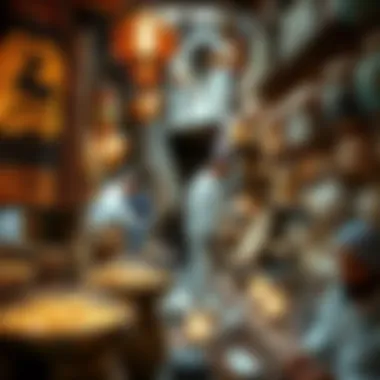
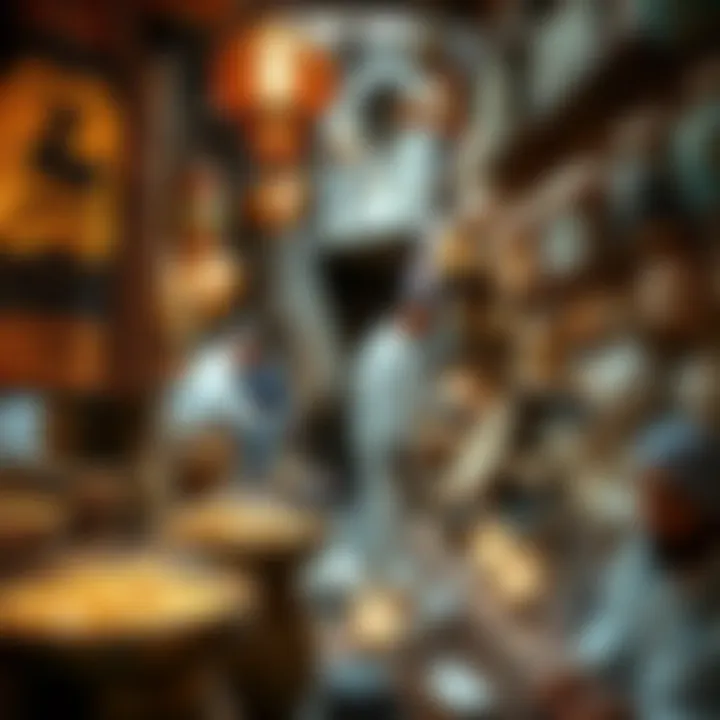
Moreover, these artisanal goods have value beyond aesthetics; they also serve as sustainable economic solutions for local communities. Encouraging the sale and appreciation of handcrafted items fosters a sense of pride among artisans, keeping traditional practices alive in an ever-evolving marketplace.
Supporting Local Artisans
A crucial aspect of engaging with traditional crafts is the impact it has on supporting local artisans. When consumers choose to buy these handmade items, they are directly contributing to the livelihoods of the craftsmen and women behind the creations. Rather than purchasing mass-produced items, many who visit the souks find joy in acquiring pieces rich with tradition and character, often crafted with personal stories and local materials.
By shopping at the souks, visitors also become ambassadors of culture. They help sustain age-old techniques and practices that might otherwise fade into obscurity amidst globalization. As the saying goes, "buy local, think global", a sentiment that resonates strongly in the context of Dubai’s craft markets.
Key Takeaways
- Traditional crafts in Dubai’s souks tell a rich cultural story.
- Artisans produce goods that are both functional and aesthetic, thus preserving heritage.
- Supporting local artisans strengthens the community and sustains cultural practices.
Engaging with local artisans is more than a shopping trip; it’s a step towards keeping tradition alive.
By immersing yourself in the world of traditional crafts, you not only enhance your experience but also contribute to a cycle of appreciation and sustainability, ensuring that Dubai’s unique cultural heritage is preserved for generations to come.
For more information about Dubai's culture and crafts, visit Wikipedia or explore community initiatives at Reddit's Dubai section.
The Hidden Gems: Lesser-Known Souks
When most folks think of souks in Dubai, their minds might whisk to the famous Gold Souk or the bustling Spice Souk. Yet, tucked away in various corners of the city, lesser-known souks offer a rich tapestry of experiences. These hidden gems not only reflect the storied culture of the Emirates but also provide unique perspectives on local life, making them invaluable for anyone wishing to delve deeper into Dubai's identity.
Exploring these lesser-known souks opens doors to genuinely discovering the heart of Dubai. Beyond the glittering gold and aromatic spices lies a realm of authentic tradition, craftsmanship, and community. Here, visitors can interact with local artisans, explore intricate handmade goods, and witness age-old practices in the midst of a rapidly modernizing city.
There’s a sense of tranquility combined with a charm that’s often lost in the more commercialized markets.
Al Seef Souk
Al Seef Souk, nested along Dubai Creek, embodies a blend of heritage and modernity. The souk's design pays homage to traditional Emirati architecture, complete with wind towers and wooden beams, creating an ambiance that transports you back in time while still offering modern conveniences. One can easily meander through its narrow pathways, where shops proudly display handcrafted goods that represent local culture and craftsmanship.
At Al Seef, you might stumble upon delightful Emirati handicrafts, including beautifully woven baskets and pottery that tell a story of their own. The souk also embraces diverse influences and features various culinary offerings, from local street food to upscale restaurants. This culinary diversity allows one to enjoy authentic Emirati dishes, combining flavor with culture.
When visiting Al Seef, don’t forget to check the schedule for cultural events and exhibitions that often take place in this vibrant area. These are designed to highlight local art forms and give visitors a glimpse into the emirate's rich heritage.
"Al Seef is a testament to the balance between preserving tradition and embracing modernity."
The Textile Souk in Bur Dubai
The Textile Souk in Bur Dubai paints a vivid picture of colors, patterns, and fabrics. Unlike the mainstream markets, this hidden gem showcases an incredible selection of textiles from around the world. From silk to cotton, and everything in between, it reflects the global trading spirit of Dubai. This souk provides an insight into the craftsmanship and artistry prevalent in textile production.
As you walk through the narrow alleys, you’ll encounter vibrant fabrics draped over stalls, each one calling out to be touched and admired. The shopkeepers often share stories about their textile origins and can guide you through selecting just the right fabric for that special outfit or project.
The ambience here is marked by genuine interaction. Bargaining is not just expected; it’s part of the rite of passage when shopping here. A friendly negotiation often leads to better prices and happy exchanges, letting both buyers and sellers leave with smiles.
In addition, don’t miss exploring the adjacent shops that also deal in traditional garments like Abayas and Kaftans, which makes Bur Dubai’s Textile Souk a must-visit for anyone interested in fashion or fabric.
By seeking out these hidden souks, visitors gain insights into the lifestyle, traditions, and daily rhythms of Dubai that often remain obscured behind the flashiness of its more tourist-centric attractions.
Practical Tips for Visiting Souks
Visiting the souks in Dubai can be an exhilarating experience, steeped in rich tradition and bustling with life. However, familiarity with certain practical tips can make your visit more enjoyable and meaningful. Understanding the layout of the markets, as well as the nuances of bargaining, can significantly enhance your shopping experience and allow you to tap into the vibrant local culture.
Navigating the Markets
When you step foot into one of Dubai’s souks, be prepared for your senses to be bombarded. The aromas of spices, the glitter of gold, and the vibrant colors of textiles combine to create an atmosphere like no other. However, it can be a bit overwhelming to navigate. Here are some strategies to help you make sense of it all:
- Know the Layout: Many souks, such as the Gold Souk and Spice Souk, tend to have a somewhat labyrinthine layout. Grab a map or use a navigation app to avoid getting lost amidst the shops.
- Time Your Visits: Early mornings or late afternoons are generally less crowded, allowing for a more relaxed experience. Plus, you might catch vendors who are more eager to negotiate before the busy rush sets in.
- Stay Hydrated: Dubai can get hot, especially during the day. Make sure to carry a bottle of water with you. Many shops offer complimentary water, but it’s wise to come prepared.
- Dress Comfortably: Wear comfortable shoes; you’ll be doing a fair bit of walking. Lightweight clothing is recommended too, as the heat can be intense.
- Embrace the Local: Learning a few Arabic phrases can go a long way, even simple greetings or expressions of thanks. It shows respect and can create a better rapport with the vendors.
With these pointers in mind, you can wander into the souks with confidence and immerse yourself in the unique local culture.
Bargaining Techniques
Bargaining is not just accepted in Dubai’s souks; it’s practically a rite of passage. Vendors expect haggling and may even be disappointed if you don’t take the plunge. Here are some handy techniques to keep in your back pocket:
- Research Prices First: Before you begin your shopping, have a rough idea of what items should cost. This could save you from overspending and arm you with knowledge during negotiations.
- Start Low, but Fair: When you begin bargaining, offer a price that’s lower than what you’re willing to pay. This gives you room to maneuver. However, make sure it’s within a sensible range to avoid offending the vendor.
- Use Silence to Your Advantage: Don't be afraid of silence throughout the negotiation process. Letting a vendor digest your offer can sometimes lead them to lower their price, just to fill the void.
- Be Friendly but Firm: Maintain a friendly demeanor while standing your ground. Smiling often breaks the tension and can lead to a better bargain. A little charm can go a long way.
- Know When to Walk Away: If the price doesn’t match your expectations, don’t hesitate to walk away. Often, this can prompt a vendor to reconsider and offer you a better deal.
In summary, having a well-planned approach to navigating and bargaining can lead to a successful and enriching experience at Dubai's souks. Engaging with the local culture enriches the experience, offering a glimpse into the heart of the city's trading history.
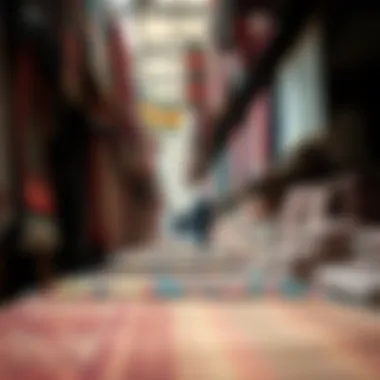
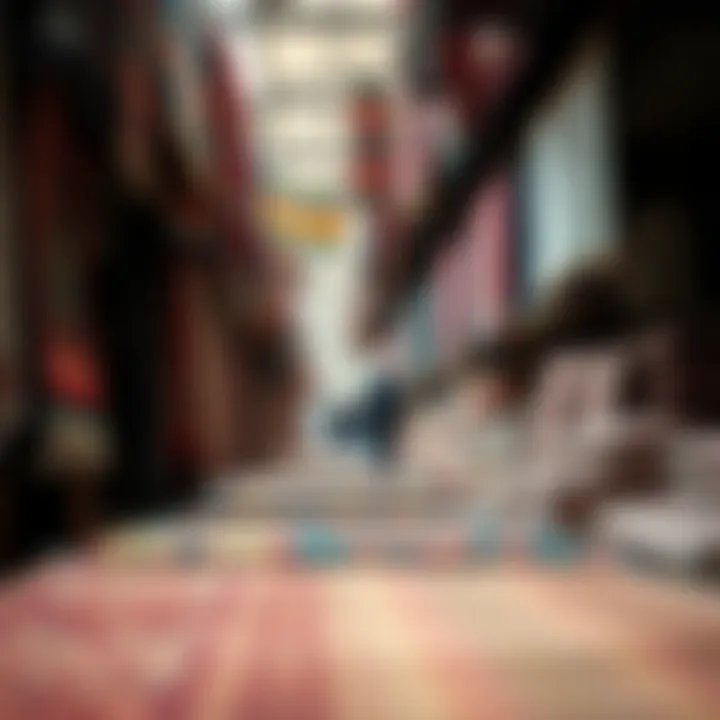
Combining Souk Visits with Other Attractions
When one ventures into the vibrant souks of Dubai, an immersive experience awaits that goes beyond mere shopping. These markets are like a rich tapestry, intertwining tradition with modern flair, history with the present moment. By combining souk visits with nearby attractions, visitors gain a deeper understanding of the cultural and social fabric of Dubai. It elevates a simple shopping trip into a full-blown exploration of the city’s multifaceted character.
Understanding this aspect of travel planning in Dubai provides tangible benefits. Firstly, it enables tourists to maximize their time. Instead of feeling rushed or overwhelmed, weaving local attractions into the itinerary creates a more streamlined experience. A well-planned day can look something like this: starting at the Gold Souk in the morning, followed by a visit to the Dubai Creek, and then indulging in something delicious nearby. It’s about making the most of the diverse offerings without the frantic back-and-forth.
Beyond convenience, visiting souks alongside notable landmarks opens doors to a plethora of educational opportunities. Tourists can immerse themselves in local stories, learning about how the souks have evolved alongside Dubai's rapid growth. Plus, while you’re wandering through shops filled with spices or textiles, a stopover at a museum or historical site brings context to the experience. The juxtaposition of ancient trading practices and cutting-edge architecture paints a more comprehensive picture of Dubai.
Some key considerations arise when combining visits:
- Timing: Planning visits in a way that respects the operational hours of each location can prevent any overlap. Not all attractions maintain the same schedule, as some might close earlier in the afternoon while the souks are vibrant for longer.
- Distance: Understanding the geography of the area can save a lot of hassle in travel. Knowing which attractions are within walking distance can enrich the exploration experience.
- Tour Guides: Many attractions offer guided tours that incorporate local insights. This could make for a more informative experience.
Ultimately, integrating souk visits with other attractions creates a rich, rewarding experience that honors the past while embracing the future. It transforms your time spent in Dubai into a mosaic of sights, sounds, and flavors.
Nearby Tourist Spots
Close to the bustling souks lie a number of attractions that beckon visitors. For example, the historic Dubai Creek is just a stone's throw away from the Textile Souk. You can hop on an ancient abra and half-close your eyes; you might see generations of traders plying their trade on the banks. The Dubai Museum, located in the old Al Fahidi Fort, offers fascinating insights into the soul of Dubai, showcasing its journey from a fishing village to a cosmopolitan hub. Wander through the narrow alleyways of Al Seef, a nearby heritage district that seamlessly blends modern comforts with traditional architecture, providing great photo opportunities.
Dining Opportunities in the Vicinity
After a day filled with rummaging through the souks, a visit to nearby eateries can truly cap off the experience. The aromatic dishes available offer a taste of the region that draws from diverse cultural influences.
- Al Bait Al Quds: Located near the spice souk, this restaurant serves traditional Arabic food and is well reviewed for its shawarma and falafel.
- Creekside: With a view of the water, it’s a great spot to enjoy a laid-back meal after a day of exploration.
- Ravi Restaurant: A bit further into the area of Satwa, this eatery is famous for its authentic Pakistani cuisine, attracting both locals and expats alike, often bustling with energy.
Dining near the souk means you can reflect on your day’s discoveries while indulging in hearty local fare, like grilled kebabs or freshly made hummus, all wrapped up in that warm, enveloping atmosphere typical of Arabic hospitality.
Exploring Dubai’s souks in conjunction with the city’s many attractions allows visitors to feel the pulse of a place rich in history and culture. Each visit, meal, and landmark paves the way for a deeper connection to this extraordinary city.
Trends Influencing Souks Today
As the cultural heart of Dubai, the souks are constantly evolving to meet the demands of both locals and tourists. Understanding these trends sheds light on how traditional markets adapt in the face of change, ensuring their continued relevance in today’s fast-paced world. Modernization and digital advancements are reshaping the dynamics of shopping, making it essential to explore how the souks are responding to these influences.
Impact of Modernization
Modernization has cast a long shadow over the traditional souks, changing the way they operate, as well as how visitors perceive them. Gone are the days when one would rely solely on face-to-face transactions; now, the modern shopper is looking for convenience and efficiency. This has pushed many souks to upgrade their facilities, incorporating air conditioning and paved walkways for a more comfortable shopping experience. These changes not only attract tourists but also cater to the expectations of a contemporary consumer.
Additionally, many sellers have added digital payment methods that resonate with tech-savvy younger generations, shifting away from cash transactions. This transformation isn't just about aesthetics—it's about survival in the global retail landscape. Souks now often blend the old-world charm with new-age technology, creating a unique shopping experience that blurs the line between past and present.
- Local merchants have embraced modern aesthetic designs to make their shops more appealing.
- Many souks organize cultural events or themed nights, making shopping a more immersive experience.
- The rise of gourmet food stalls in these markets showcases how traditional offerings are melding with global culinary trends.
Role of Online Platforms
In addition to the tangible changes within the souks, the rise of online platforms has profoundly reshaped how these markets operate. Many traditional merchants are tapping into e-commerce to widen their reach, something that wasn't common a decade ago. Through social media platforms, local artisans market their handicrafts to a global audience, allowing for a new kind of interaction.
Websites focused on local goods enable merchants to take orders online, further enhancing customer convenience. This shift toward digital retailing allows artisans and small businesses to showcase their wares beyond the physical boundaries of the souk, tapping into new revenue streams and customer bases. It's a win-win situation; the vendors benefit from extended market reach, while consumers enjoy the diversity available at their fingertips.
"Local souk sellers have begun to see how online platforms can bridge the gap between traditional market charm and modern shopping expectations."
As the line between physical and digital commerce continues to blur, savvy visitors looking to explore Dubai's souks may benefit from leveraging these online tools to plan their visits better, ensuring they don’t miss out on unique finds or special promotions. People can also engage with vendors remotely, thus fostering a deeper connection to the products and their origins.
Overall, the trends influencing Dubai's souks reveal a market in transition—one that respects its deep-rooted traditions while embracing the innovations of the modern era. This balance is essential for preserving the cultural significance of these markets, as well as keeping them relevant in the bustling city of Dubai.
Closure: The Enduring Allure of Dubai's Souks
The souks of Dubai represent a confluence of history, culture, and modernity that is deeply embedded in the city’s identity. As we've explored, each souk offers a unique experience, from the glistening trinkets of the Gold Souk to the aromatic spices that fill the air in the Spice Souk. These markets aren't merely places to shop; they serve as living museums showcasing the rich tapestry of Dubai's heritage.
Why the Allure Persists
Over the years, the allure of the souks has persisted for several reasons:
- Cultural Immersion: The souks provide a window into the local way of life. Tourists and residents alike can engage with artisans and learn about traditional crafts that have been passed down for generations.
- Unique Offerings: Unlike modern malls, where products feel uniform and mass-produced, souks offer a plethora of unique items that you won't find anywhere else. This individuality often comes with a story, making each purchase feel more special.
- Bargaining Spirit: The art of negotiation is alive and well in souks. Unlike set prices in retail chains, haggling becomes a part of the experience. This gives buyers a sense of control and connection to their purchases—transforming the transaction into a memorable act.
- Global Village: Dubai’s souks attract a melting pot of cultures, creating a vibrant marketplace filled with interactions that go beyond buying and selling. This interplay of cultures adds layers to the shopping experience.
- Sustainability Trends: With rising awareness about sustainability, local artisans and craftspeople are gaining traction. Souks promote local products, which supports community economies and helps reduce the carbon footprint associated with mass production.
The Future of the Souks
As modernization seeps into every corner of Dubai, the challenge lies in preserving the soul of the souks while embracing innovative trends. This balance is crucial. The fusion of tradition and modern commerce can create an environment where both visitors and locals can thrive.
"The soul of Dubai is alive in its souks, where every stall tells a story, each interaction is a memory in the making."
By returning often to local souks, patrons don't just shop; they support livelihoods, engage with history, and partake in an ongoing narrative of cultural significance.
Final Thoughts
For more information, consider visiting resources like Wikipedia or Britannica. These platforms can provide deeper insights into the cultural and historical context of Dubai's vibrant souk scene.
Remember to explore, engage, and enjoy the charm that lies within these bustling markets.




